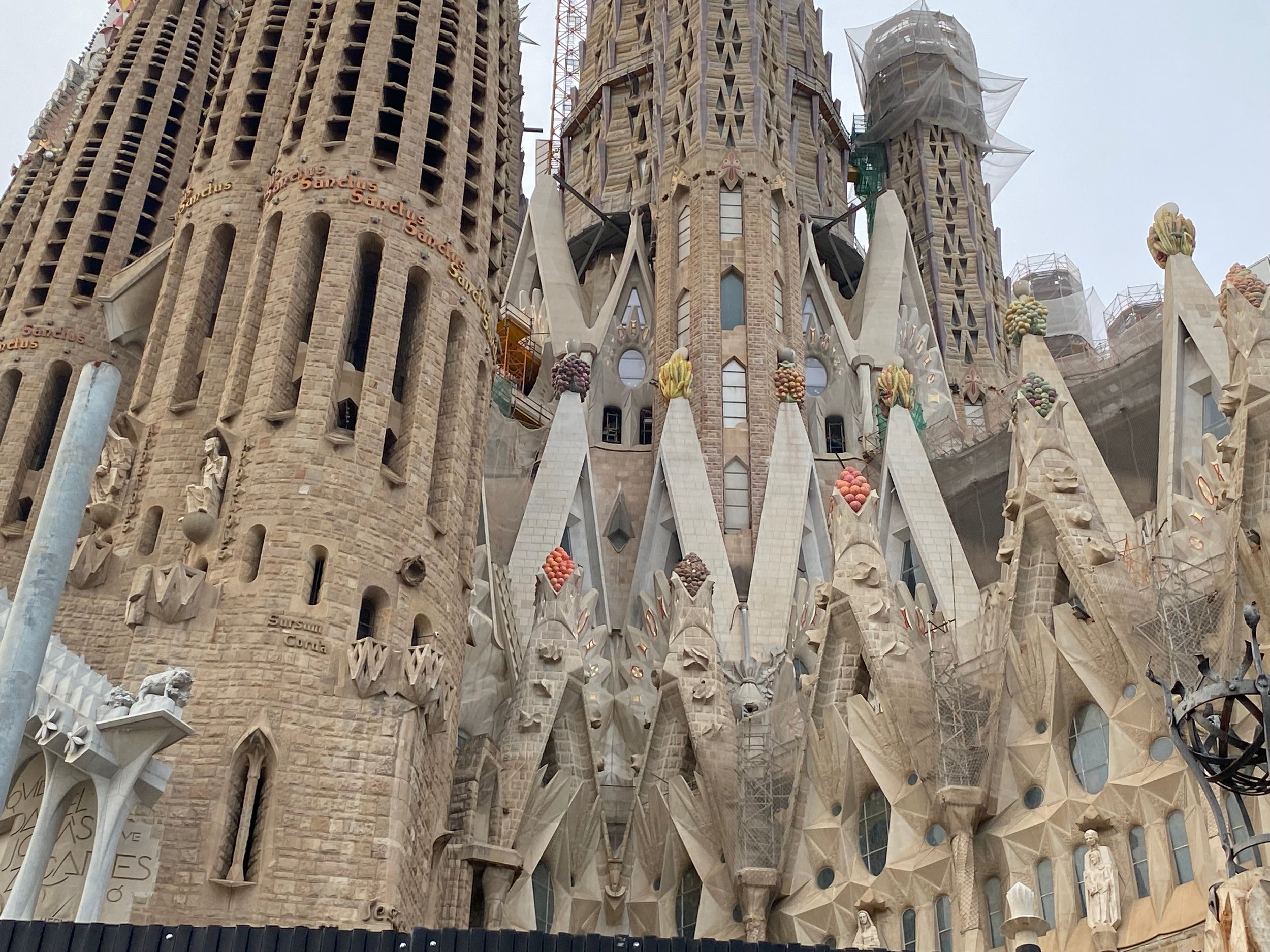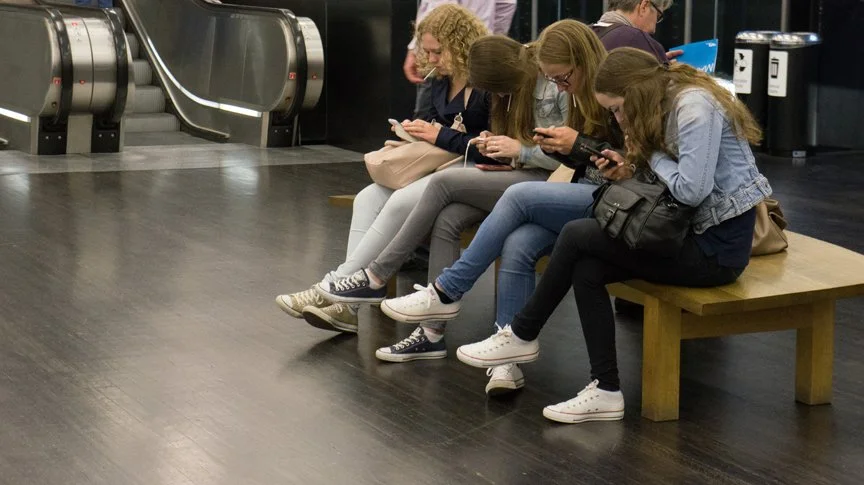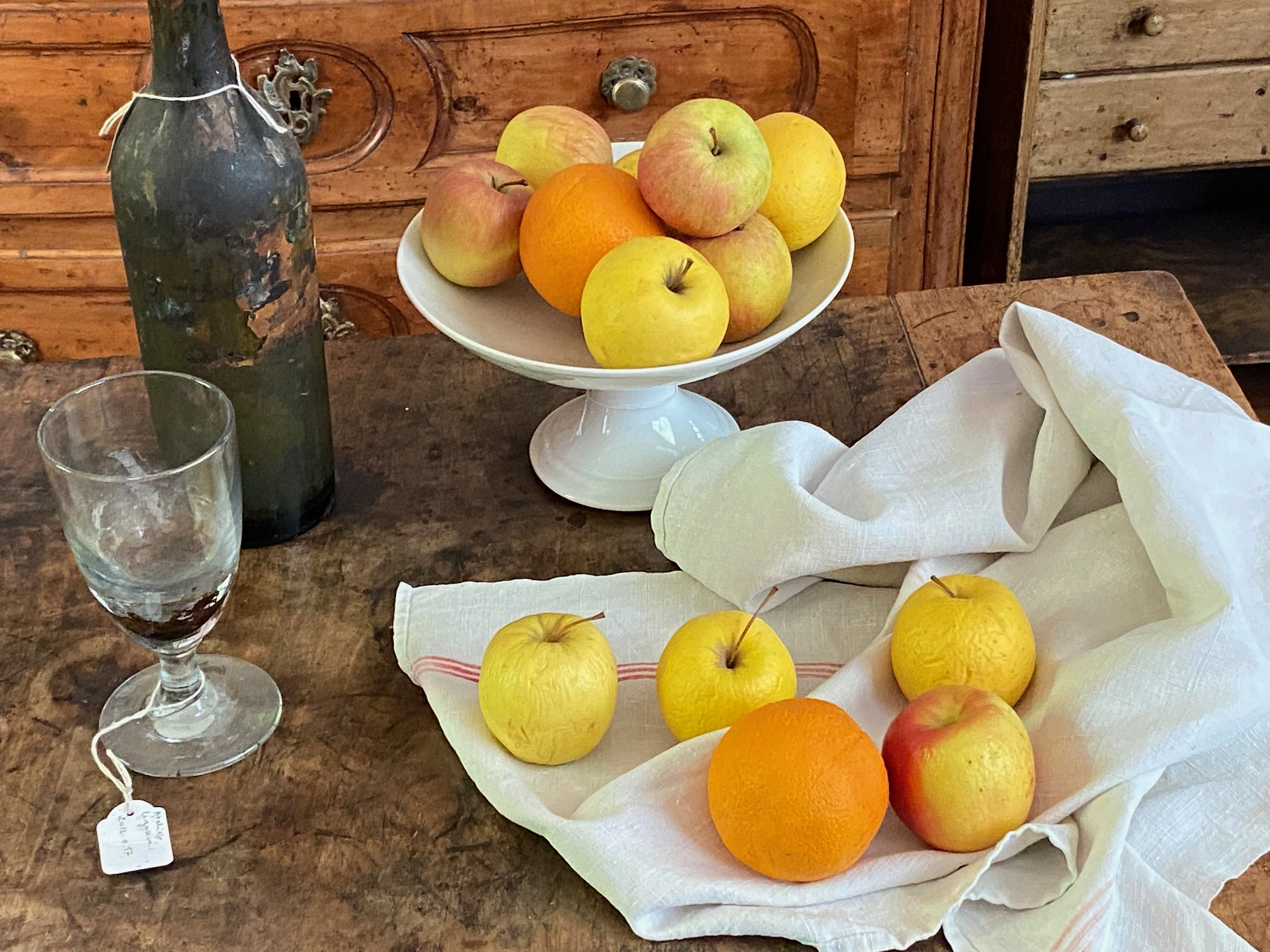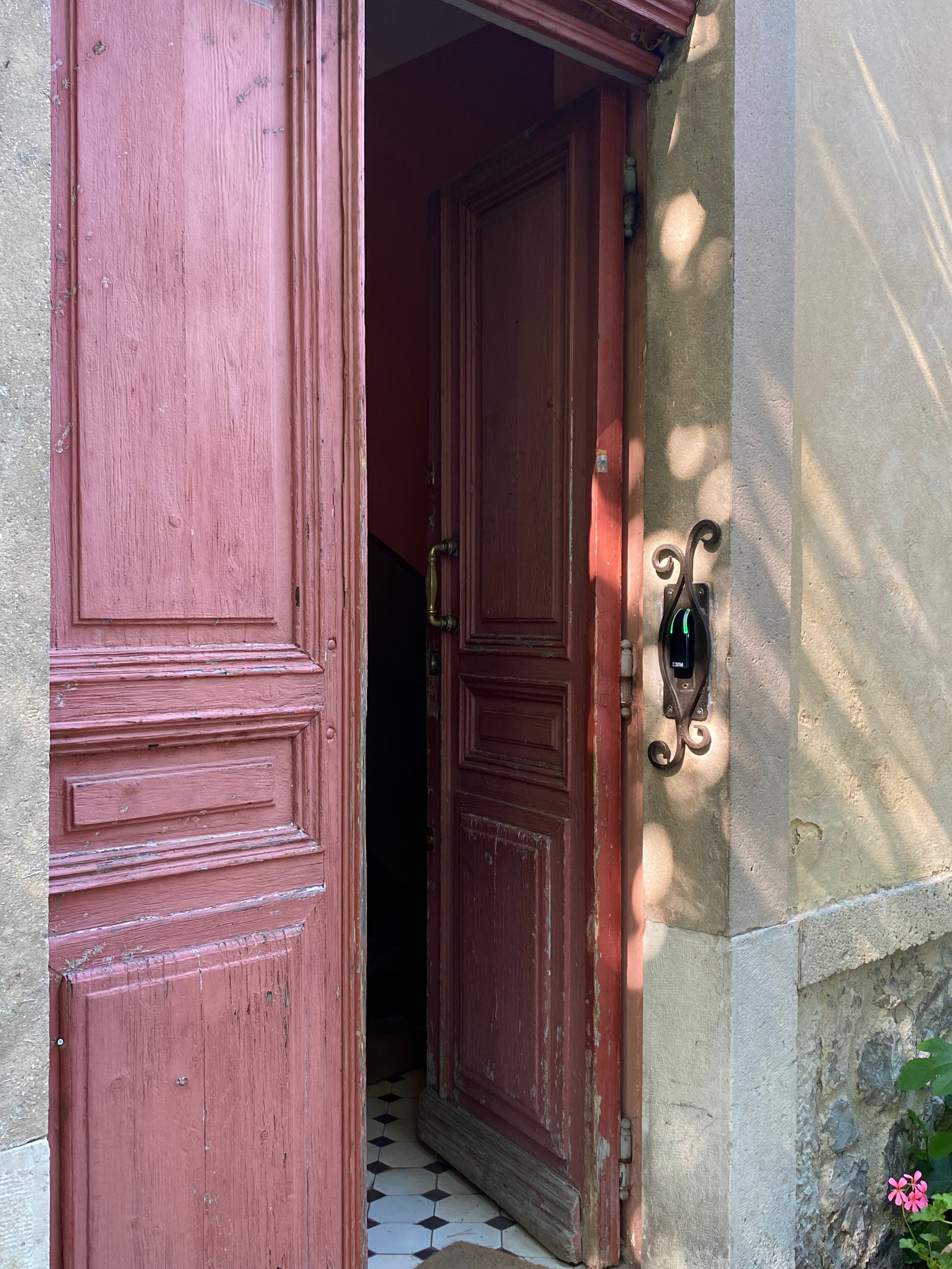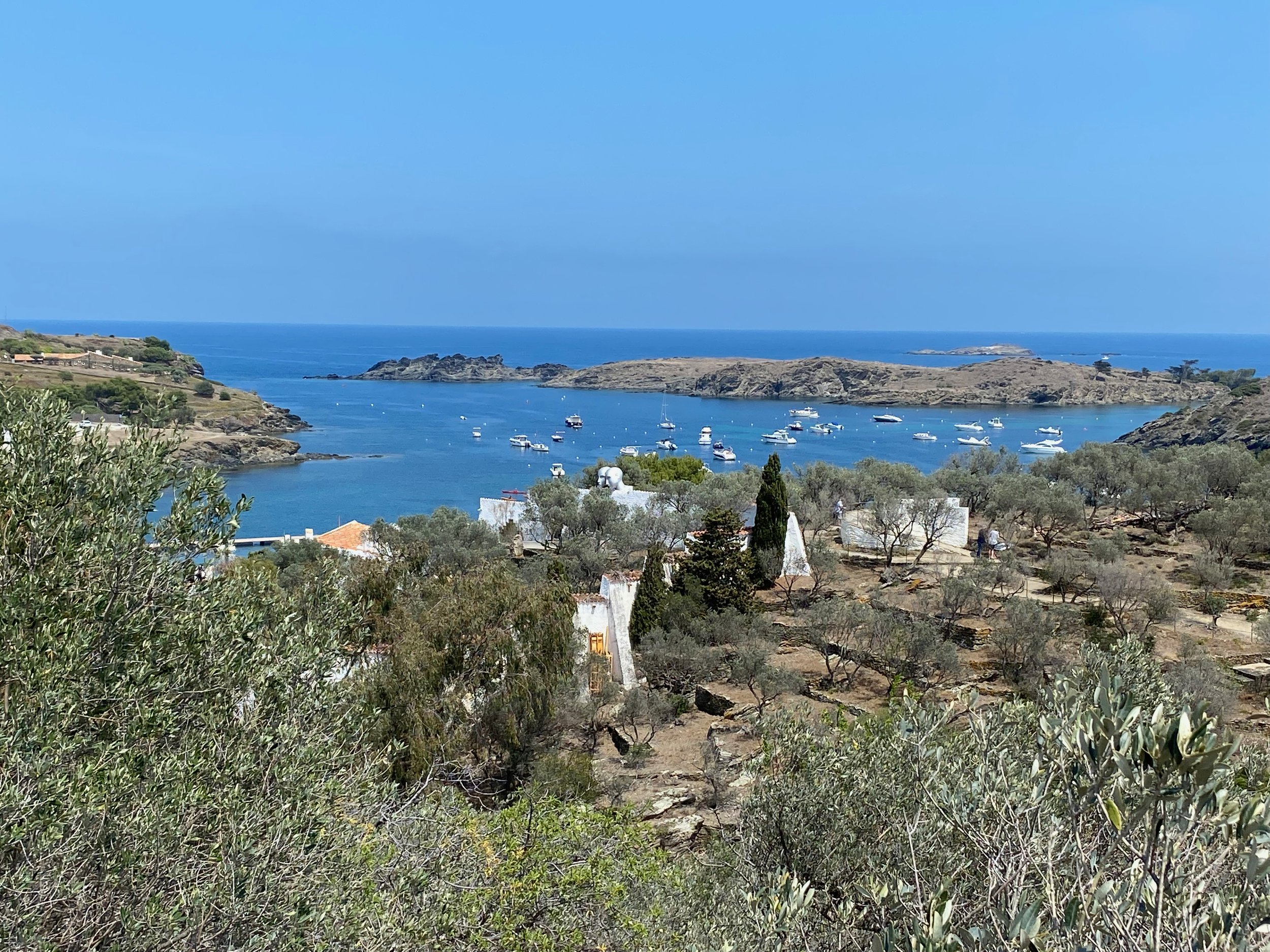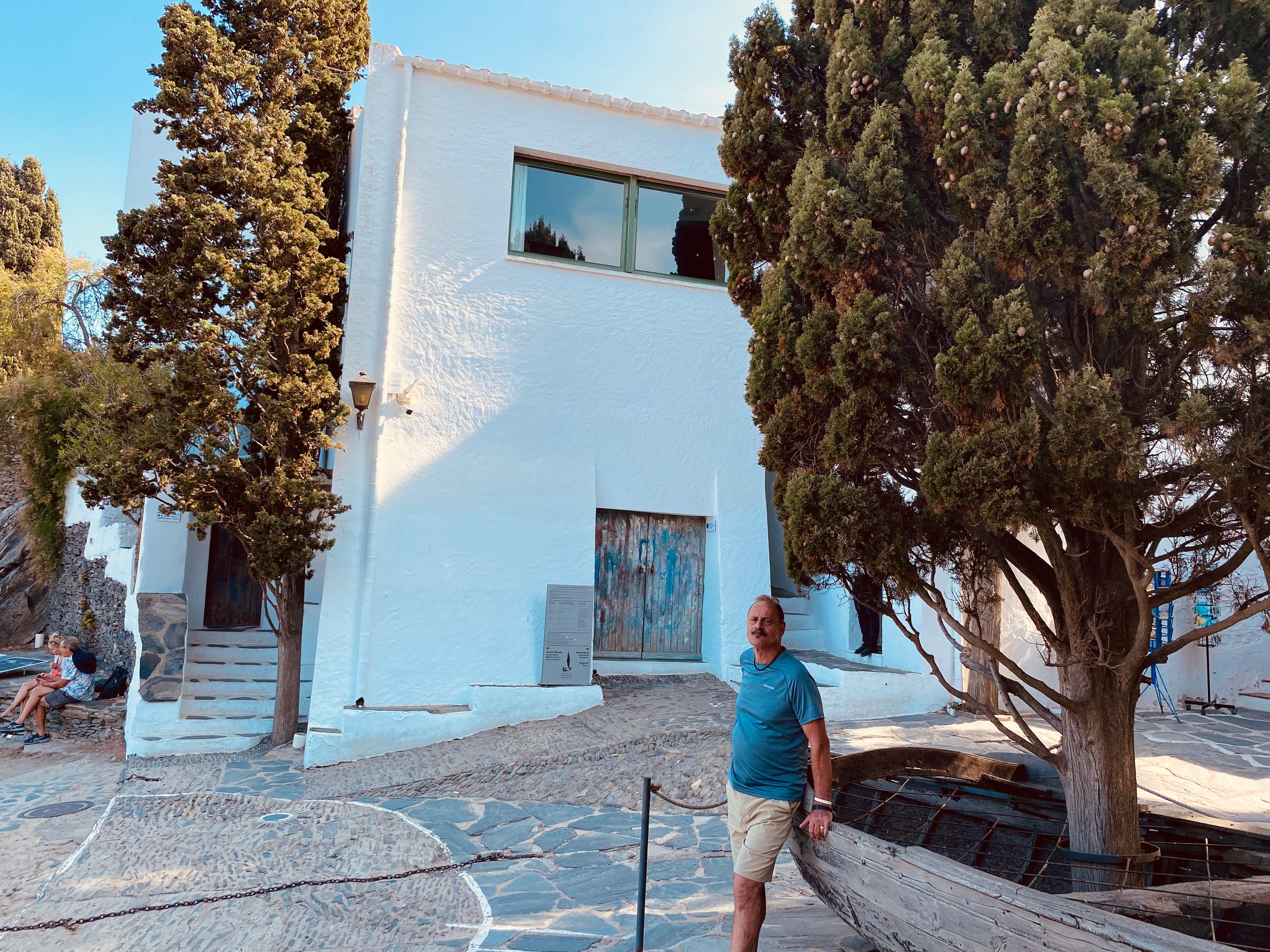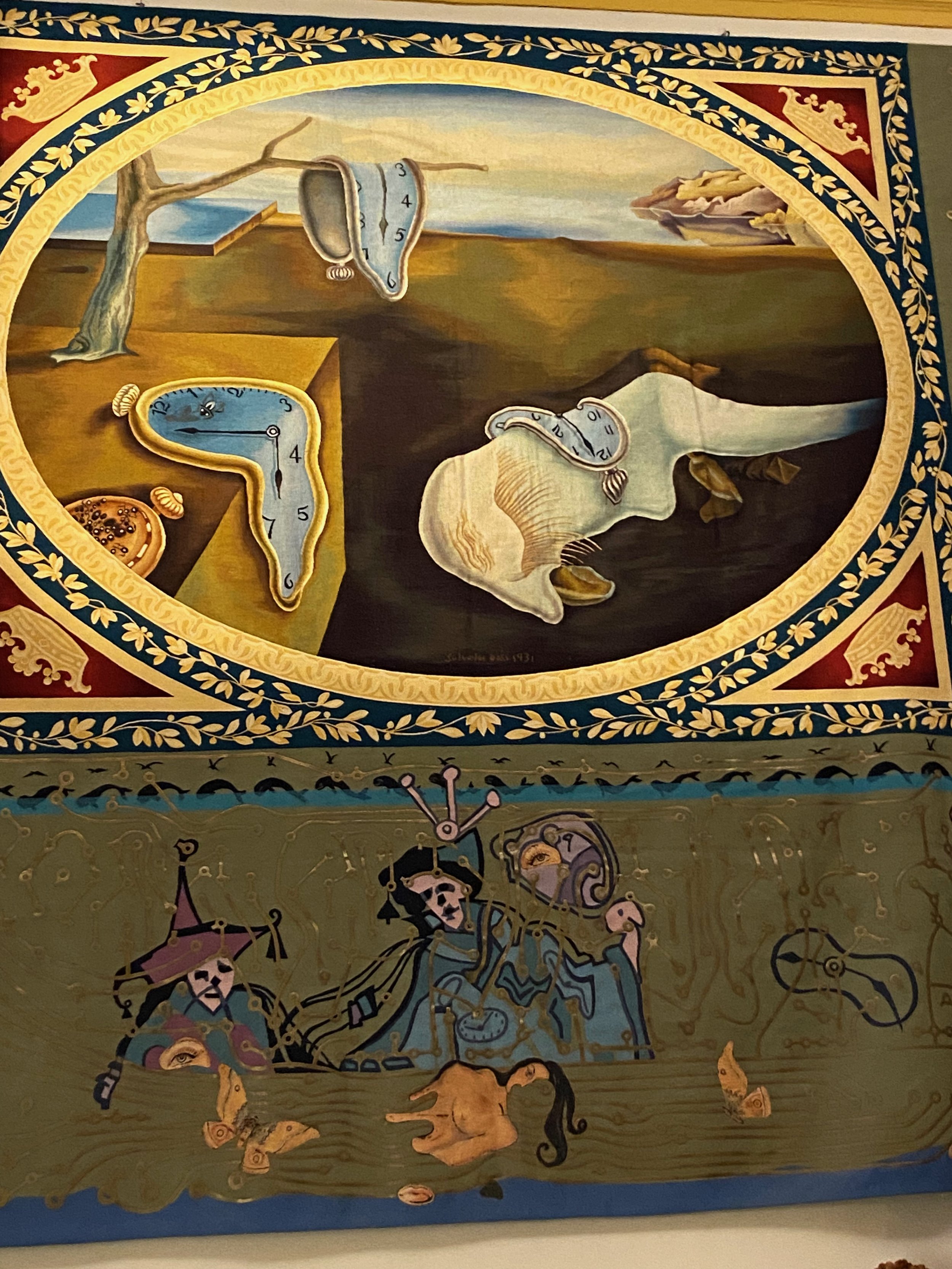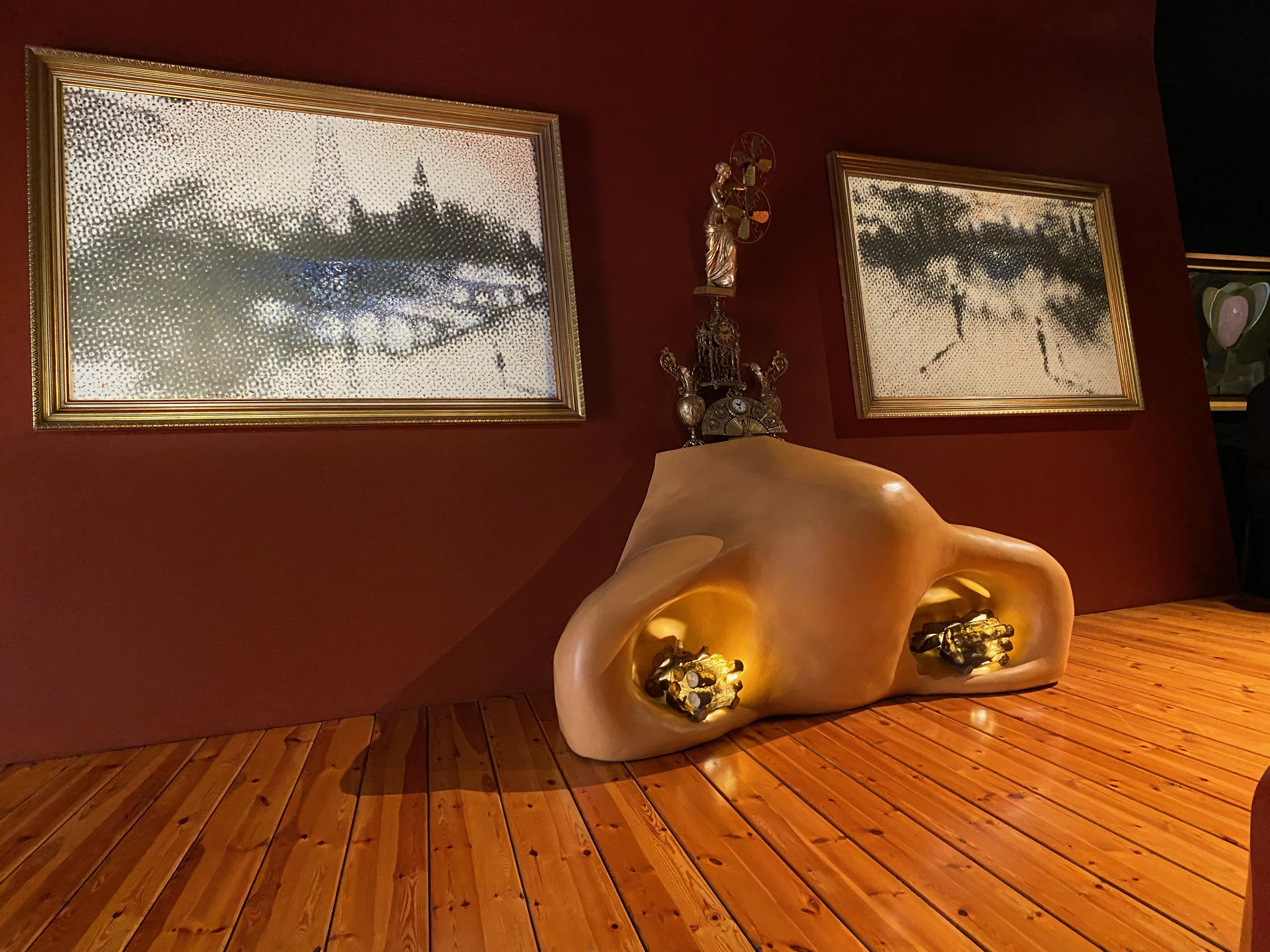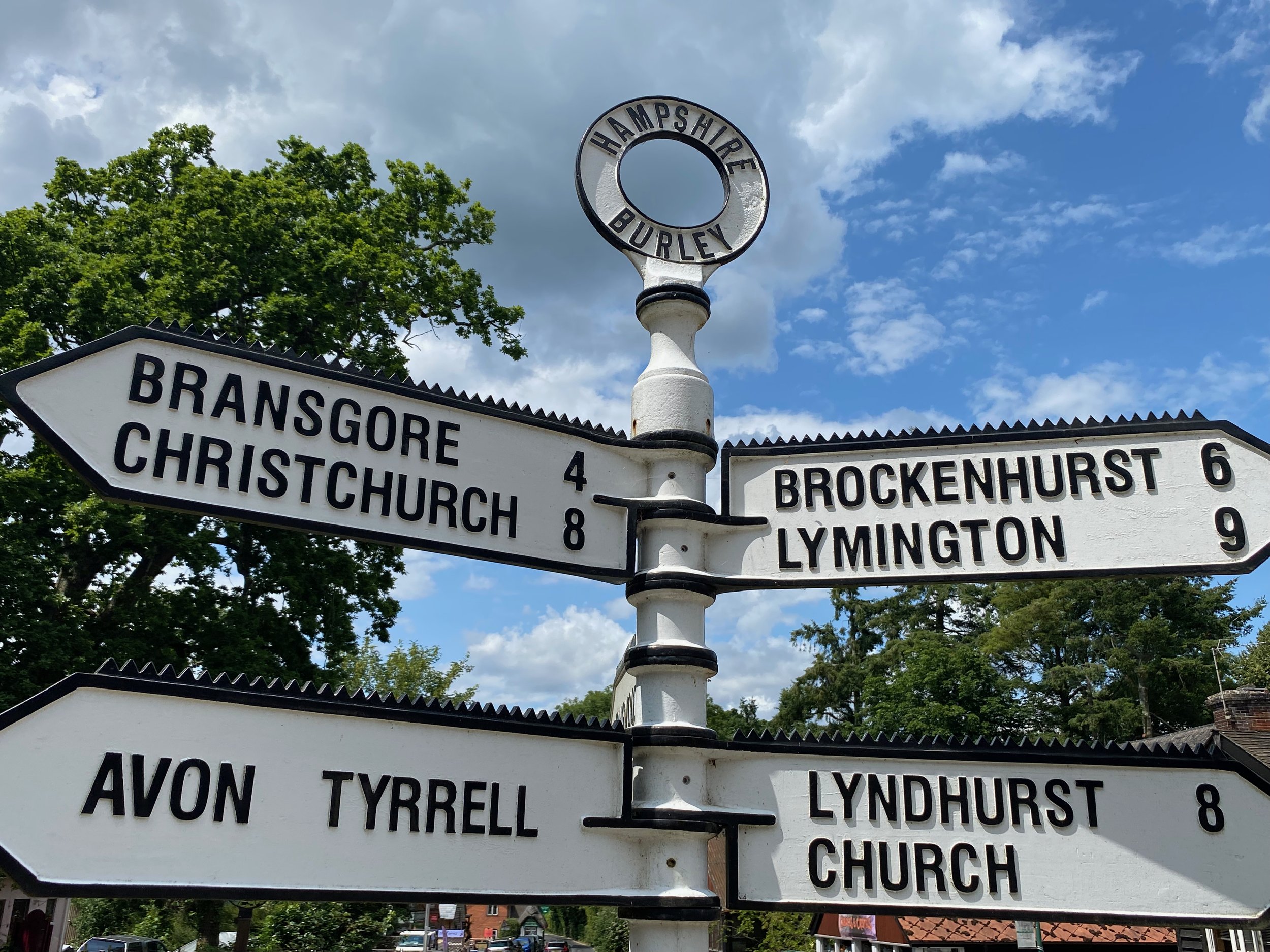Last Days With My Father
This sketch was made during a month-long sailing trip with my father. On the way back to England we pulled into Guernsey (one of the Channel Islands). One morning I found myself in a quiet alley and sat down to sketch. I didn’t know it at the time, but in a few months my dad would no longer be with us. The shadow implies that someone had once been there, but had just walked away and was no longer visible.
LAST DAYS WITH MY FATHER, OIL PASTEL
This sketch, which I called “Last Days with My Father”, has since been lost to time. It was probably left behind during one of our moves. I have no idea where it is today.
But I wanted to share its “backstory” and how it came about.
While I was living in the San Francisco Bay Area—around the summer of 1988—I was having my daily quiet time with God when I had a very strong impression that I needed go back to England to see my father. Not my mother, just my dad—which, in itself, was rather strange!
I went to the director of Harbour House, the Christian inner-city program where I was working full time, and asked if I could take two weeks leave to go back to see my father. She, with great wisdom, said, “If you feel that strongly about it you should go for a month”. I flew back to England. Dad and I prepared for our trip then set sail from Christchurch over to Cherbourg, France.
My father on his boat in Christchurch harbour
We spent the next month sailing along the coast of France. It was just me and him, sleeping onboard the boat in harbours with names like Saint-Vaast-la-Hougue and La Havre. We shopped in markets, cooked breakfast on the boat and went out for lunch in little local restaurants. We stayed two or three nights in one place, then sailed on. It was a magical time.
On the way back to England, we stopped in Guernsey (one of the Channel Islands) for a few nights. It was during this time that I took my pastels and went out for a walk. I ended up in a quiet alley and sat down to sketch. Somehow the alley captured my feeling of sadness at the time. Without realising why, I added the faint shadow, as if someone had been there shortly before but had just walked away and was no longer visible.
We sailed back to England and I returned to California.
A few months later we got the news that my father had “gone in for tests”. My wife Joan said, “It’s just a test, he’ll probably be fine, but somehow I knew he wouldn’t be. I told her that I didn’t think he would make it. A few weeks later he died. The whole time we had been sailing the cancer had been in his body. My father didn’t know, and I certainly didn’t, but God did, and I will always remember those four weeks He gave us together.
The beauty of water
I love water. I find it unendingly beautiful. Water in all its forms—lakes, ponds, streams, waterfalls, rivers and oceans, fountains in small villages in Spain or France, coral lagoons in the islands of the South Pacific—almost always brings a sense of peace, reflection and rest. When light and water meet, the spectacular happens.
I love water! Water in all its forms—lakes, ponds, streams, waterfalls, rivers and oceans, fountains in small villages in Spain or France and coral lagoons in the islands of the South Pacific—almost always brings a sense of peace, reflection and rest.
What could be more enjoyable than to sit beside water with a sketch book and watercolours, trying to capture the patterns of colour, the reflections, refractions and diffusions, as water and light transform each other?
Golden light shining through a shallow river in New Zealand.
When light and water meet, the spectacular happens. In art, light is everything. It transforms everything it touches. The ordinary becomes spectacular in an instant.
A celebration of silver, grey and white during a winter’s day on the south coast of England.
Clouds, mists and fogs are nothing more than water suspended in air. But when light shines onto, around or through them, they become breath-taking. Frozen water (snow) becomes beautiful in the presence of light.
A morning on the Avon river in England—shrouded by mist.
This painting, called Reef, Samoa was painted after I walked out across a reef in the Pacific Island of Samoa. Peering down into cracks between the rocks into the depths, the brilliant blues and greens became deeper and more mysterious. I wanted to capture the liquid colors of water as they flowed around the rocks. I glued paper and cardboard to the paper, added texture paste then poured liquid acrylic paint and let it run, mix and flow across the surface of the painting. I repeated this at least eight times, building the layers until I was satisfied that the paint captured the movement of the water flooding in and out of the crevices.
Reef, Samoa. A tribute the blues and greens of the South Pacific lagoons.
Almost all of the forms water can take inspire a sense of peace!
Water from a farmhouse gutter becomes drops of silver.
Throughout the world, artists have been (and are) fascinated by water. Monet was just one of many who was influenced and inspired by water.
Just one of the beautiful “water landscapes” that Monet produced at his home in Giverny between 1897 and his death in 1926.
I walked in awe through the Plitvice Lakes in Croatia—a staggeringly beautiful series of lakes, emerald and crystal clear, both large and small, that descend from one to another in an endless series of waterfalls.
This is only a small section of the Plitvice Lakes in Croatia—the whole place is a celebration of water!
With water comes sound; water lapping against boats in a harbor, the crash of surf on an isolated beach, the peaceful gurgling of a small brook or the almost imperceptible sounds of a slow-flowing river.
The Alhambra, in southern Spain reflects Islamic architecture’s love of water. Throughout the immense palace water is integrated into every facet of its design. Water is both cooling and peaceful in this hot part of Spain, bringing a sense of quiet religious reflection.
Water played a crucial role to the Moors in Alhambra in southern Spain. In a land of great heat, water cooled the buildings, nourished gardens, powered fountains and created a place of stunning beauty and peace.
Water itself is often considered sacred. The Te Waikoropupu springs in the South Island of New Zealand are the clearest spring waters in the world. Underwater clarity tests have shown the water to have underwater visibility of 63 metres. The springs are wahi tapu—a “sacred treasure”—to the local Māori and it is forbidden to touch the water, so visitors walk on a wide board pathway above the water.
The smaller of the two springs is called the "Place of the Dancing Sands” because the water pushes up through the white sand bottom of the spring floor, moving the sand particles and making them appear to dance!
The water from the main spring is a constant cold temperature of 11.7°C and incredibly blue and clear. Being at Te Waikoropupu felt like being in a cathedral!
South Island, New Zealand
Walking out onto a harbour, into the fresh breeze, I was struck by the beautiful shades of greens and blues, framed by the darker harbour walls on both sides. I could almost "feel" the currents and movements in the water. Beyond lay thousands of miles of open ocean. There was an immense sense of peace in this place, only disturbed by the occasional cry of the gulls.
The Spaces Where Art Lives
Why is going into an art gallery the last thing the average person wants to do? Is the problem with the public, who are just not “into art” anymore? Is it the galleries, who make people feel uncomfortable and unwelcome? Is the fault with the artists, who produce work that is inaccessible to the average person? How can we show our work in a more creative way that invites more people in and makes them feel welcome?
Why is going into an art gallery the last thing
The average person wants to do?
Not long ago I suggested to my daughter that we go and visit some art galleries. She was in her late twenties at the time, loved fashion, film, interior design and music, but was as excited about going to “see some art” as making a trip to the dentist!
Next, I contacted some friends who had lived in Melbourne for 15 years, thinking they might have some connection with the art scene there. They said, “Sorry, I don’t think I’ve ever been into an art gallery here”.
Is the problem with the public, that they are just not “into art” anymore? Is it the galleries, who make people feel uncomfortable and unwelcome? Or is it the fault with the artists, who produce work that is inaccessible to the average person?
Recently, at the Barcelona Museum of Contemporary Art (MACBA), I sat for 15 minutes watching a video of some trees blowing in the wind, then viewed some childishly-scribbled artwork (below) before giving up and leaving.
How can we show our work AND CREATE SPACES that
inviteS people in and makes them feel welcome?
More and more I am discovering that the environment in which art is shown is as important as the art itself.
Some galleries are inviting, friendly and even provide opportunities for people to discover the joy of creating. Others, sadlyare stark, white and sterile, maintaining a, “Don’t touch, this is serious art!” attitude. Places to be tiptoed around in complete silence, before beating a hasty retreat!
Give me colour, give me clutter, give me chaos…
but don’t give me boring!
I am discovering that—rather like when dining out—only half the experience is the food. The other half is the setting in which the food is served. You can have great food (art) in a sterile, unfriendly, bland setting or bad food (art) in a fun, friendly environment with cheerful waiters and good music—but neither are a fully satisfying experience.
But how can we as artists combine engaging art and interesting and inviting spaces?
Can we combine art with music, dance, poetry, story-telling, jewellery and sculpture in order to create spaces that surprise and delight?
Can we create spaces large or small, urban or rural, in remote places or the centre of major cities that encourage people to have conversations, that inspire contemplation and reflection and present art along with good wine, beautiful gardens and great food.
Below I share some of the places I have had the privilege of visiting in the last couple of years that might serve as jumping off points for ideas about how we present our art.
Donna Demente’s Grainstore Gallery
I stumbled upon Donna’s Grainstore Gallery by accident while wandering the streets of Oamaru, a quiet seaside town in the South Island of New Zealand.
Upon entering, I felt myself relaxing…the whole environment was peaceful but intriguing. Gregorian chant was playing and Donna was working away. But was this her studio, a museum or a store-room for discarded art? Her work has been called a “mix of drama, pre-Raphaelitism, taxidermy and metaphysics!” Wow!
Donna in her studio, filled with clutter and beauty!
An eclectic mix that always surprises.
Steampunk HQ
Next I stumbled upon the Steampunk Headquarters. Steampunk “captures a time when the future and its technologies collide with Victorian-era experiments (think Frankenstein) gone wrong. A future with a dark side of grime and decay”.
The whole building, inside and out, was covered with strange distorted animals, flickering video screens, bits of metallic insects and rusted, twisted machinery.
One of the highlights was the “metagalactic” pipe organ—a “device for capturing sounds and signals picked up by Time-Travel Officers when visiting alien worlds. Some say that special combinations of notes will open up time portals within the building to exotic alien holiday destinations”.
The whole experience was fun, disturbing, alarming and intriguing—and so much more engaging than a “regular” art gallery!
Matapihi in Raglan
Whenever I visited Raglan, a surfy/artsy community on the West coast of New Zealand, I would visit the Matapihi gallery. (Sadly, it has since closed down). It had a fascinating mix of original paintings, hand crafted jewellery, raranga (flax weaving), pounamu (Maori greenstone carving) and clothing. Matapihi was “run by artists, for artists, from an artist’s perspective”. I loved that it had a kitchen in one corner and a fireplace in the other and felt like being home. It was a humble, creative space.
Home studios in Queenstown
Queenstown is a tourist destination in New Zealand’s South Island. It also has a large arts community, and it was fantastic to stroll from one art gallery to another with a backdrop of snow-clad mountains. I found one in an old chapel, another in a stone cottage, while others were spread around the town. I loved spending time with artists in their home studios, talking with them about their work, goals and visions. Many had beautiful cottage gardens, which only added another layer of beauty to the experience!
So personal, so small working gallery!
Home studio of Tim Wilson
I had seen Wilson’s work in a gallery in downtown Queenstown—very large paintings of the mountains and lakes that surround Queenstown. He was renowned for his stunning depictions of natural beauty and was one of the highest-selling artists in New Zealand. When Tim passed away in 2020, his canvases were moved up to his amazing house with views out over the lake. We were shown around in a very small group by a woman who loved and admired his work.
Standing in Tim Wilson’s studio…in front of the last painting he worked on but never completed.
Angus Watson’s home studio
Angus Watson’s home studio lies outside Queenstown. Even as we approached the colourful front door, I knew I was going to enjoy this space! Outside was a beautiful garden, while inside art covering the walls and was stacked on the floors.
The Tate Modern
On a trip back to England after 15 years away, I took a train up to London and went for a stroll along the Embankment besides the Thames. I felt like a visitor to my own country. I walked past the Eye (new to me!) I stumbled upon the Tate Modern. I no idea it even existed—but remembered seeing the old Bankside Power Station during my days as an art student. The architects had retained much of the original character of the huge building including the 35 meters high and 152 meters long turbine hall!
I walked in…and stood amazed. The experience of walking into such a massive, voluminous space left me wordless. And to see great art in such a setting was phenomenal. And all for free.
The Sagrada Familia in Barcelona
This is easily the most creative and inspiring place I have ever seen. The whole massive structure, both inside and outside, is art. I didn’t know much about this stunning place until we went to Barcelona in 2023. I discovered that Gaudi was an incredibly creative person, a humble, faith-filled man who started and ended each day by going to church and praying. Each day he tirelessly worked on the creating the deeply spiritual space that is the Sagrada Familia (which translates as the Holy Family). One day he was hit by a tram on his way home and badly injured. Nobody helped him because he looked poor and had no identifying papers with him. He died three days later in a hospital for the poor.
This amazing video that shows what the Sagrada de Familia will look like: once it’s finished!
The Case Dali
I hadn’t been much of a Salvador Dali fan. In art school his “melting watches” were viewed as too theatrical and commercial to be “real” art. All that changed when I visited the Casa Dali in Spain. In 1930, attracted by the light and extreme isolation, Dali and his wife Gala bought a small fisherman’s shack with no heat, no electricity and no running water, just steps from the Mediterranean Sea. He lived and worked there for the next 52 years. Over the decades he extended the property, piece by piece and room by room until it became the amazing place it is today. Rooms and corridors are now filled with drawings, prints, painting and strange, surreal installations and sculptures.
When Dali set up his studio in a fisherman’s shack the bay was deserted and completely isolated.
Standing outside Dali’s house, right on the beach.
Dali’s painting supplies just as he left them in his studio at Casa Dali.
Cézanne’s Studio
My visit to Cezanne’s atelier (studio) in Aix-En-Provence was an emotional experience. In the quiet of the large room where he spent so much of his time, I was able to sit where he sat, next to the massive window that let in the light that was so important to him.
Nearby were the pots, bottles and the little white statue he used in so many of his paintings, as well as a table set up with fruit on a white table cloth, exactly as it looks in many of his still-lifes. The clothes he wore each day hung in one corner, his easel sat in another.
When he painted here the atelier was outside of town and had a view of Mt. Sainte-Victoire, the mountain he painted in 36 oils and 45 watercolours. Now it is on a busy road, surrounded by apartments and the view is gone.
Sadly, after his death the studio was locked up and nobody entered for 15 years. At one point developers wanted to knock it down! The studio and garden around it are now protected.
Marc Chagall - in a small stone church in south france
I was taken aback to discover some of Chagall’s wonderful stained glass in a tiny church in a small village in the south of France. He was a Russian-French artist of Belarusian Jewish origin. How did his work end up here? He created works in a wide range of formats—painting, drawings, book illustrations, stained glass, stage sets, ceramics, tapestries and fine art prints. Finding some of his art in such a humble, obscure setting made it all the more special.
The bizarre world of steampunk
Steampunk HQ is fun, crazy and intriguing and a little bit scary. Is it art? Who knows? It’s a futuristic vision of 19th century Victorian England “gone mad”. Its significant influences were H.G. Wells and his time machine, Jules Verne and “20,000 Leagues Under The Sea” and Alan Moore's super heroes in “The League of Extraordinary Gentlemen”. Futuristic technologies are taken back into the “ornate and opulent world of grand fashion and gentlemanly manners”, a future with a dark side of grime and decay. It’s like one of those crazy Victorian science experiments (think Frankenstein gone wrong)!
I stumbled upon the Steampunk Headquarters and was blown away by the experience, not least because it is in a quiet seaside town on the South Island of New Zealand known for…its penguins!
Is it art? Who knows? I found it fun, disturbing, engaging, alarming and intriguing. The HQ piles strangeness upon strangeness—every corner is filled with distorted metal animals, bits of old machinery and eclectic collections of recycled industrial art that is rusted and twisted into something else.
Apparently Steampunk is a “quirky and fun genre of science fiction that features steam-powered technology”. It is a futuristic version of 19th century Victorian England “gone mad”. Its significant influences were H.G. Wells and his time machine, Jules Verne and “20,000 Leagues Under The Sea” and Alan Moore's super heroes in “The League of Extraordinary Gentlemen”.
Futuristic technologies are taken back into the “ornate and opulent world of grand fashion and gentlemanly manners”, a future with a dark side of grime and decay. It’s like one of those crazy Victorian science experiments (think Frankenstein gone wrong).
The “punk” in steampunk represents a rebellion against the present day preference for plastic and the disposable way of life. One of the highlights was the “metagalactic” pipe organ. It is described as a “device for capturing sounds and signals picked up by the HQ time travel Officers when visiting alien worlds. Its sounds were “captured during space-time jumps to earth” and its special combinations of notes opens up time portals to exotic “alien holiday destinations”. Well, there’s no answer to that! Nothing at the Steampunk is as it seems. There is little here that you just look at, most of the time you are compelled to engage with it, move something, push a button or, at times, just wonder what it is! A Doomsday Clock was ticking away, somehow quite chilling. Strange electronic faces leered out of the darkness.
Anything can be influenced by Steampunk: literature, art, music, film, fashion, technology, invention, jewellery and sculpture.
My favourite experience was “The Portal”—a stunning “retro-futuristic” installation of what seemed like hundreds of thousands of glowing light skulls sculptures. Each light was in fact a reflection of other lights, which in turn mirrored other lights. It felt like hanging silently in outer space, surrounded by galaxies of shining stars.
(Later in the afternoon I went to a “regular” art gallery—in comparison I found it quiet, sterile and a bit sad after this experience!)
For times and prices etc go to: Steampunk HQ
The handprint website
Handprint is the most comprehensive resource for watercolor painters on the internet! It makes available huge amounts of practical information for the aspiring artist who wants to learn about all aspects of watercolor painting: papers, brushes, paints, "color theory," painting techniques, art instructional books and more. Bruce MacEvoy says, “I created these materials for painters who are weary of art marketing hype, inaccurate art theory and the numbing workshop mentality that invites you to learn somebody else's "winning" painting style in ten easy minutes.
I love the Handprint website! It’s worth its weight in gold for the serious artist who wants to understand colour! I first came across this site years ago—and have been back hundreds of times. It’s an in-depth study of pigments and color with an emphasis on watercolour paint. It is, as Bruce MacEvoy himself proclaims, the “most comprehensive resource for watercolor painters on the internet”. As an artist I enjoy the challenge of learning the craft of painting and Bruce MacEvoy has been an extremely important part of this journey.
I’ve used it as a go-to reference guide, handbook and well, almost my “Bible” as I’m on the journey to learn about paints. (Can you tell I’m a big fan?) There is way too much information to take in at one time…it’s the kind of reference site that you will want to go back to again and again as questions arise.
MacEvoy says, “You’ll find here information on all aspects of watercolor painting: papers, brushes, paints, “color theory,” painting techniques, art instructional books and more”. He continues, “I’ve created these materials for painters who are weary of art marketing hype, inaccurate art theory and the numbing workshop mentality that invites you to learn somebody else’s “winning” painting style in ten easy minutes”. His mantra is: find out for yourself, test the paint and don’t accept the blurb from the marketers.
The Handprint website provides practical information on how to making paint swatches and charts.
He doesn’t talk about “paints”; he describes pigment and paint attributes (color appearance, pigment concentration, particle size, lightfastness, tinting strength, refractive index and specific gravity!) He explains how to carry out basic paint tests yourself—but if you won’t, he provides a massive amount of information that every artist can use.
He doesn’t suffer fools gladly and directs his ire towards “expert” artists who repeat unfounded beliefs and who are too lazy to test and evaluate the paints they are promoting.
He has no time for meaningless proprietary/marketing names like, “Royal Purple Lake” and is adament that pigments are much better and more accurately identified by their pigment numbers. He describes how PV42 (Pigment Violet 42) is called by a variety of names by different companies (for example, “Quinacridone Pink” by Daniel Smith) but the code PV42 will be the same across all brands.
I find Australian paint company Matisse to be one of the worst culprits at creating paint names like "Australia Salmon Gum" which tell you nothing about what’s actually in the tube. It's confusing because people might think, "Wow, that sounds fantastic, what a unique colour!", when in fact it’s three pigments, Quinacridone, Arylide yellow and Titanium Dioxide, mixed together for the sole purpose of selling a greater number of paints.
Bruce is big on using permanent pigments and strongly advises artists to avoid fugitive colors that fade quickly. He focuses his ire on Alizarin Crimson (PR83; Pigment Red 83). He is frustrated that many paint companies “with an entrenched and backward looking customer base”, still offer it. Some published artists continue to advocate it, “simply because a dwindling number of "old master" (age 50 and above) workshop and bistro gallery artists continue to use it”.
I myself got into a dispute with two artists who were teaching online and who claimed that Alizarin Crimson is “lightfast enough” for professional quality work, or that lightfastness concerns about it are mere "nit picking and hairsplitting".
For each fugitive colour (and there are several really bad ones a professional artist should never use) he suggests permanent alternatives.
Handprint provides a guide to help you develop your own limited palette. (This will mean you don’t have to buy hundreds of inessential pigments that are easily reproduced with a mixture of about 12 single pigment paints).
Go to his Guide to Watercolour Pigments section to see all that you will ever want or need to know about the full range of pigments: magentas, reds, oranges, yellows, greens, blues, violets and earth colours. Finally, there are many incredibly useful color charts.
Aboriginal Art
My first encounter with aboriginal art left me amazed at their colours, textures and abstract patterns. Soon after arriving in Arnhem Land, a remote part of northern Australia that feels a million miles from the cultural and artistic life of Melbourne or Sydney, I discovered an art centre that highlights and promotes art by local Yolngu artists. Sitting in silence I watched the aboriginal artists at work. I realised that there is much I don’t understand about the complex culture and story-telling of the aboriginal people. And I wondered how a people with such a long history could produce art that looks so “modern” and which reminded me of much of today’s contemporary abstract art.
A few years ago I had the chance to go to the “top end” (very far north) of Australia to visit some very remote aboriginal homelands with Mission Aviation Fellowship. MAF, an organisation that I worked with until 2022, flies light aircraft to support the local Yolngu people as they work towards a better life for their communities.
This video captures my experience of arriving in Arnhem Land, a part of Australia that feels a million miles from the cultural and artistic life of Melbourne or Sydney, and then flying into remote areas where the beaches have amazing white sand and aqua water—that you can’t swim in because of the ever-present “crocs”! While there I discovered an art centre that highlights and promotes aboriginal art by local Yolngu artists. There is much I don’t understand about the traditions, history and protocols of aboriginal life and the cultural expressions of the Yolngu people, but the art I experienced appeared to me both modern and abstract with their complex colours and patterns.
The Painter's Keys
The Painter’s Keys is a “worldwide community of artists from over 115 countries who visit the website for information, inspiration, artist advice, friendship and connectivity”. Robert Genn started emailing five fellow artists. Soon, requests trickled in to be added to the list, and he came to understand the need for a Brotherhood and Sisterhood of Artists—a worldwide community of creative people with a lot of the same concerns.
Fifteen Years of Letters by Robert Genn
I love discovering new sources of inspiration. And wow, The Painter’s Keys is a great source of inspiration! First and foremost it archives thousands of letters, written twice a week since 2000, by Canadian artist Robert Genn. Sara Genn, his daughter, says, “Dad wrote a letter twice-weekly to artists, non-stop for 15 years”.
Today The Painter’s Keys is a worldwide community of artists from over 115 countries who visit this website for information, inspiration, artist advice, friendship and connectivity.
Today tens of thousands of artists subscribe to get the weekly letters. You can sign up here. By the way, they're free.
Robert doing what he loved most, painting en plein air.
Sara says, The Painter’s Keys began in the winter of 1998 by my Dad while on a family sojourn in Southern Spain. He started with five recipients—artists he knew might accept an epistolary studio friend. Soon, requests trickled in to be added to the list, and he came to understand the idea of a Brotherhood and Sisterhood of Artists—a worldwide community of creative people with a lot of the same concerns. Of his idea he wrote, “While ours seems a simple business, there’s just so much worth knowing”.
In the Fall of 2013, my Dad was diagnosed with pancreatic cancer and told he had a year to live. Along with painting, writing and organizing his archive, he asked if I would continue the letters for as long as they might be useful. Since then, I have written every other letter and republished weekly one of Dad’s.
Robert Genn in his South Surrey, BC studio, 2012.
The website also has a fantastic Quotes page—with the world's largest collection of quotes about art!
The Books page lists an eclectic mix of essays, novels, books on the theory of painting, the practice of painting, the roots of why we paint. If, like me, you want to go deeper in your reading about art, here is just a smattering to whet your appetite:
Eternal Truths for Every Artist. Harley Brown offers artists his “truths” for painting success– the stuff he hopes they teach in art school.
The Painted Word. Tom Wolfe addresses the scope of modern art, from its founding days as Abstract Expressionism through its transformations to Pop, Op, Minimal and Conceptual.
How I Paint: Secrets of a Sunday Painter. Thomas S. Buechner asks: What is the process by which a painting comes into being? What goes on in the artist’s mind?
The Talent Code. Daniel Coyle asks: What is the secret of talent? How do we unlock it?
Life With Picasso. Francoise Gilot was a young painter in Paris when she first met Picasso—he was sixty-two and she was twenty-one. During the following ten years they were lovers, worked closely together and she became mother to two of his children.
Other titles include:
An Artist Teaches.
Awakening the Artist Within.
Wabi sabi Simple (Wabi sabi is an ancient - Japanese aesthetic that values the imperfect, the handmade and the simple).
Creative Freedom (52 strategies for getting out of ruts and venturing beyond your comfort zone).
Earthen Pigments (about hand-gathering & using natural colors from the soil).
Slow Art
Research shows that people spend as little as eight seconds looking at each painting in a museum or art gallery! Taking the time to slow down and really look at art triggers a curiosity to learn more. There is something special about investing the time it takes to engage with a painting you might normally walk right by.
It’s not what you look at that matters…it’s what you see.
Henry David Thoreau
Founded in 2010, Slow Art Days are a global event (more than 1,500 museums and galleries have participated) with a simple mission: help more people discover for themselves the joy of looking at and loving art. I’m a big fan, and these events are a growing phenomenon.
On the Slow Art Day I joined, twelve of us gathered to look at a small selection of paintings hung in the Wallace Arts Centre in Auckland, New Zealand.
The idea behind Slow Art Days developed as research showed that people spend as little as 8 seconds looking at each work in a museum. These global, all-volunteer events have a simple mission: to help more people discover for themselves the joy of looking at and loving art.
I took this photo at the Tate Modern in London of people “engaging” with the art.
In fact, anyone can volunteer to host a Slow Art Day; simply find a venue—a gallery or art museum that is open to the idea—and promote the event. Then, after an hour or so of viewing, bring the participants together to discuss their experience of the art works.
The next Slow Art Day takes place on April 13 2024. You can organise one in your neighbourhood - go here for guidelines.
One day each year people of all ages and from all over the world visit local museums and galleries to look at art…sloooowly. For example, participants may look at five works of art for 10 minutes each and then meet over lunch to talk about their experience. That’s it. Simple by design.
Some paintings may not be what they would normally like or find interesting, but when people spend ten minutes in front of each piece of art they start to make discoveries. Most importantly, they realize that they can begin to experience art without being an expert. This in turn unlocks passion and creativity and helps to create more art fans.
In an art world too often driven by money or the latest technology (NFTs, for example), Slow Art Days are passionately retro. They advocate an ancient practice – one at least as old as the paleolithic cave paintings in Lascaux, France – and that is this: slow down and look.
Sitting with Cezanne
Finally finding somewhere to park on a side street, we bought a ticket to visit Cézanne’s atelier. What I experienced, sitting in his studio was, for me a highly emotional experience. Cézanne spent most of his life painting landscapes, still-lifes and portraits in solitude and obscurity in Aix-en-Provence. Called a "lunatic" by fellow townspeople and and known as a loner, this studio is where he did most of his painting…
Sometimes bad days turn into good ones. We had set off on a two-hour drive to visit Aix-En-Provence in southern France. We had been told it was worth visiting, but when we arrived we couldn’t find anywhere to park or see anything interesting. We were about to turn around and head back to St. Paul-Trois-Chateaux, when we saw a sign for Cezanne’s studio!
Finally finding somewhere to park on a side street, we bought a ticket to visit his atelier. It was—for me—an emotional experience.
Cézanne spent most of his life painting landscapes, still lifes and portraits in solitude and obscurity in Aix-en-Provence.
I was able to sit where he sat, next to the massive window that let in the light that was so important to him.
The clothes he wore each day were hanging in one corner.
Cezanne’s easel sat in another.
When he painted here, the atelier was in the country-side outside of town. It had a view of Mt. Sainte-Victoire, the mountain he painted in 36 oils and 45 watercolours. Now it is on a busy road surrounded by apartments. The view is gone.
One of Cezanne’s many oil paintings of Mt. Sainte-Victoire.
Sadly, after his death the studio was locked up and nobody entered for 15 years. At one point developers wanted to knock it down to build flats! Luckily, the studio and the garden around it are now protected.
The front door to Cezanne’s atelier
And to think we nearly missed it this experience. We’re so glad we persisted! Get information about visiting the atelier (in French) here.
Discovering Dali
In 1930, attracted by the light and extreme isolation, Salvador Dali and his wife Gala bought a a small fisherman’s shack, just steps from the Mediterranean sea, with no heat, no electricity and no running water. Dali lived and worked here for the next 52 years. We had been told that getting tickets to see this house would be completely impossible at such short notice. We set off by car anyway, determined to see the “Casa Dali” for ourselves.
First, a confession…I have never been much of a Salvador Dali fan. In art school he was snickered at and considered too “too slick” or “commercial”. We were directed towards abstract painters like De Kooning, Jackson Pollack, Rothko etc. Dali, with his “melting watches”, was thought to be too theatrical to be a “serious” artist.
All that changed when I saw his work first and caught a glimpse of his years as an artist.
We had been told at the Tourist Information in Giron that it was absolutely impossible to get a ticket for a tour of his house at such short notice. Despite that, we drove a narrow, winding road over a small mountain (nobody had mentioned this!) to the Casa Dali, or “Dali’s house”. We walked down to the house, up to the ticket window and were offered two tickets for a tour starting in 20 minutes!
In 1930, attracted by the light and extreme isolation, Dali and his wife Gala bought a a small fisherman’s shack with no heat, no electricity and no running water, just steps from the Mediterranean Sea.
The view of Casa Dali and the Mediterranean on the walk down to where he lived and painted for 52 years.
Standing outside his house, metres from the water.
Dali lived and worked here for 52 years. Over the decades he extended the property piece by piece until it became the amazing place it is today.
His painting supplies, just as he left them.
In 1982 Gala died and his life fell apart. He was unable to work and eventually moved into what became known as the Castillo Gala Dali de Pubol (or the “castle of Gala and Dali at Pubol”). In a way, these years were the “second stage” of his endless creativity that began in his house on the Mediterranean.
The amazing Castillo Gala Dali de Pubol was opened to the public in 1996.
Rooms and corridors were filled with drawings, prints, surreal installations and sculptures. And of course his “melting watches” oil paintings for which he is so well known.
His “Ascension of Christ” shows Jesus ascending into the sky, flanked by angels. It fills the whole ceiling in one large room.
I was also surprised to learn about the life of Gala, who by all accounts was deviant, manipulative, spiteful, controlling and endlessly promiscuous! At one point Dali could only visit her by requesting an appointment via hand-written letter. But at the same time she was the major driving force behind his career, promoting his art and endlessly pushing Dali succeed as an artist.
Dali’s wife Gala.
When I get home from this 3-month trip and after learning so much and being inspired by experiencing first-hand the life and work of Dali—as well as Cezanne, Gaudi and Picasso—I plan to start studying art history all over again!
TWO CONVERSATIONS (THAT changed my life)
We all have dozens of conversations a day. Most are instantly forgotten. A few are fuelled by vision and purpose, with people who have life experience and wisdom. Recently I had two such conversations. They were both so significant that I went straight home and wrote everything down. I didn’t want to miss anything from these conversations! They changed the direction of my art!
All of us need to challenged at times. We get stuck, sidetracked or distracted. Sometimes we need a good friend to give us a kick up the backside to keep going! At other times we need to know we have people standing with us who care about us and share our vision. Key conversations at the right time can make all the difference.
If you don’t have people like this, be proactive, find someone who knows you well and values your art, and ask them to journey with you. These are two such conversations as best I remember them…
Julie Spence, who has since gone to be with her God.
CONVERSATION ONE
HOLD FAST TO YOUR VISION
I have been part of Youth With A Mission (YWAM) here in Auckland, New Zealand for many years. One Friday morning I walked down for morning tea (a New Zealand tradition) and recognized Julie Spence, who I had last seen in Hawaii. Julie was Dean of the College of Arts in YWAM (she has since passed away).
What followed was an hour and a half heart-to-heart conversation in which God spoke directly to me through her. Not your “normal” conversation, it was both encouraging and challenging.
I could be really honest with Julie, since she has been through similar challenges herself.
I started by explaining that our organisation had lost five of the seven buildings on our campus and most of the land we once hoped to buy. Staff numbers have dropped and many times I had grieved the loss of the dream that once seemed so bright.
Julie answered, “Nothing is achieved without struggle”
“YWAM has lots of “success stories”, but we don’t often hear the stories of struggle. There have been times of loss and disappointment in YWAM. There are seasons in life.
I said that some leaders had made “big vision statements” but disappointment followed when these “prophetic statements”, for whatever reasons, didn’t come to pass. She responded, “You must learn to be single minded—don’t worry about what others say, what did God say? If God said it, do it. Don’t compare yourself with others or with their vision—what God has told you to do? Spend time with Jesus, listen to his heart. You can’t stay in this place. Get back up and move forward. You can’t allow these things to hold you back from doing what God wants you to do”. She suggested I read the book, “Failing Forward”.
Julie continued, “We all face disappointments. There’s lots we don’t understand about God and why things happen the way they do. There just is! We have no way of explaining or understanding everything God allows to happen.
I said that I felt called to start a creative arts program, bringing together painters, photographers, graphic design, video, animation, music and dance. Julie said, “You need to have strong vision. People are attracted to vision. This vision needs to come directly from God, not from others.
You will find out that some people will share your vision and be excited by what you are doing and stand with you—but many won’t. They won’t see the value of what you want to do. Identify with those who do and build strong relationships with them. Go to them and ask them for guidance—don’t wait for them to come to you.
Don’t think you are alone
There are already others with similar vision around the world. Join them, connect, network, share the vision.
As Dean of the College of Arts, I need people who will hear from God and fight for what they want to achieve. There are huge challenges in whatever we do for God. It’s almost never easy. All leaders go through times of extreme stress and testing.
Julie went on, “Once, in China I didn’t get a permit to hold a major event until 25 hours it was scheduled to begin! Some people dropped out, others became disillusioned and started to doubt and question. There have been times when we have had to cancel programs, people didn’t show up, money didn’t come. I felt humiliated. My husband has had major health problems. The question is: Are we going to give in, run away from the problems and become disappointed or stand and fight for what God has said? We must all learn to persevere and fight through the adversities.
Don’t wait for others
You be the one to step forward, you be the solution. Something initially may look insignificant but start with what you have now. Don’t despise the small beginnings. Many successful programs in YWAM looked stupid to those around at the beginning”.
At the end of our time together Julie said, “This morning has been a foundational time. We met here today for a reason. It wasn’t just “chance”. God has been doing something today!”
CONVERSATION TWO
Developing GOALS - and HOLDING THE COURSE!
My son-in-law Tyge phoned asking if he could stop by later. When he arrived, we sat down and he asked me a hard question: “Is your art just a hobby or something more serious?”
I answered that I did indeed want to take it out of the hobby category and make it something much more professional.
His next question: “So, what are you doing about it?”
Me: Uhhh….hmmm…!
He then asked, “Are you being effective? How many galleries have you talked to?” I came up with a few (pretty lame) examples of places I had emailed and some I had talked to—one was a café/gallery at which we had attended an Opening the week before, with a possibility of showing my work there. He told me that I need to stop dreaming and start doing.
I had to admit in the end that in terms of building of my art business almost nothing had happened. He said it had been months now and he keeps hearing about my dreams for my art, but nothing concrete actually gets done. He reminded me on Sunday at church the talk had been about how God moves in partnership with us; we take the initiative and make the first move, then God responds…we take the next step, then God responds again. Tyge challenged me not to just sit back and expect God to drop something into my lap. “If you just sit and wait for God to do everything, nothing ever gets started. We do what we can, then God does what only He can!
Know where you want to go
Be intentional about creating a plan. We talked about me stopping painting for a while to create a window of time to develop a business plan for marketing my artwork. He quite rightly pointed out that I love to be in my studio painting, but what is the point of having dozens of finished paintings sitting around that nobody ever sees? I need to have a solid plan in place for promoting my art. One that I could build on over the years ahead.
His advice was to stop painting for a season and prioritise writing a business plan for the next few years.
I mumbled about the possibility of finding a person who could do some of the groundwork, who could represent me and contact galleries on my behalf. He answered, “People buy paintings from a person they know. They are in fact buying you and their relationship with you, not just the art. Gallery owners want to see and talk to you face to face, they want to hear about your vision and work from you directly, not from someone else. You can’t get around the fact that nobody can represent you better than you.
We moved on to the topic of pricing. You may need to bring down your prices as you build your reputation. I was reluctant to do so and pointed out how much materials cost (here in New Zealand, watercolour paper is $44 a sheet, one tube of paint can run $30 and framing costs $200). In the end we agreed to find a middle ground in terms of pricing.
Next, “What about your website?” Well, I explained, I have my work on Art Span. (A large website with tens of thousands of other artists on it). He asked, “How much have you sold through it?” I paused. “Actually…nothing”.
By the end of the afternoon, we had agreed on my next steps
I will get hold of some good lights and you will have two days to photograph all your paintings.
You will then design and post a website that reflects the quality of your work.
You will design and print a professional-looking brochure with samples of your work and some business cards. You will put everything into a folder, so when you walk into a gallery you can present your art in a professional way.
And you will develop a schedule to go out and start connecting with galleries.
He challenged me again: there are times where we need to sacrifice something we are holding onto in order to clear the way for God to move. What, he asked, could I fast—give up—for 21 days in order to see God move in taking my art business taken to the next level? The great thing was that Tyge was not only going to hold me accountable to get these things done but very willing to help in any way he could. He said times; this is doable (I needed to hear this!) You have the skill, now you have to be confident and committed to seeing it done!




















































